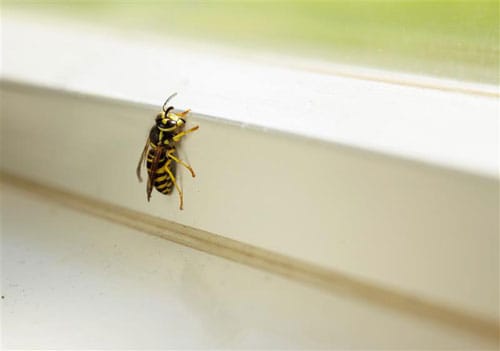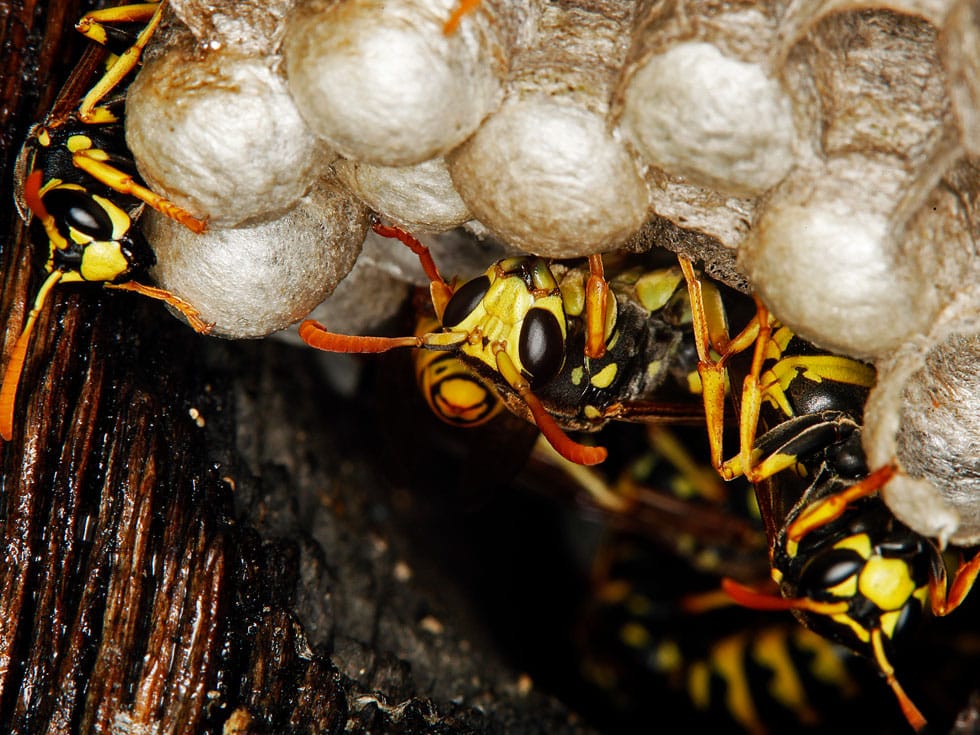It can be hard to ignore wasps flying around the house or terrace in summer. While they can seem intimidating, these insects nonetheless play an important role in our ecosystem.
Find out how to efficiently and safely repel wasps from your home.
Do you have questions or concerns? Contact Avalanche Extermination for advice on the presence of wasps on your property.
Preventing the arrival of wasps: good habits to adopt
When the warm days of spring arrive, wasps are quick to follow and start flying around terraces, balconies and gardens. As they are attracted by certain odours, colours or hiding places, they often take up residence without being detected.
Understanding what attracts them will make it easier to adopt good reflexes that will help prevent them from becoming a permanent member of your immediate environment.
What attracts wasps?
Wasps are attracted by several factors which are present all around many homes, such as:
- Food: Leftovers from meals left outdoors, barbecues, recipients containing sweet foods, or waste bins that are not tightly covered. These are a feast for wasps.
- Scents: Whether they originate from very fragrant flowers or body care products with a fruity or floral odour, these fragrances attract wasps on the hunt for nectar.
- Water sources: Pools, drinking fountains for animals or standing water encourages them to stay nearby.
- Potential shelter: Roofs, shallow walls, tool sheds or other uncaulked structures are perfect spots for wasps’ nests.
Wasp prevention tips
A few simple habits can make all the difference to avoid having wasps setting up residence around your home or in your yard. Take up the following routine as soon as spring arrives:
- Inspect your property and your home for any wasp nests that may already have started.
- Keep outdoor trash bins tightly covered and place them further away from human activity.
- Rince out recyclable containers before putting them in the recycling bin, especially those that contained sweet beverages.
- Avoid leaving uncovered food or beverages outdoors.
- Cover glasses, bottles or cans when eating outdoors.
- Prefer wearing subdued-coloured clothing (bright colours attract wasps).
- Limit the use of floral or fruity perfumes during outdoor activities.
- Regularly check that soffits, shallow walls, fences and tool sheds are correctly waterproofed.
- Apply caulking to cracks and install mosquito screens if required.
Natural solutions to ward off wasps
There are several natural methods that help keep wasps away without harming the environment.
Household tips and home-made wasp repellents
Certain odours can naturally ward off wasps:
- Cloves;
- Slightly burned coffee grounds;
- White vinegar or garlic;
- Sachets of dried aromatic herbs like mint, lavender or basil.
Repulsive plants and essential oils
Some plants and essential oils can be a deterrent to wasps while providing a pleasing fragrance to your outdoor space:
- Plants to grow around the house or on the balcony:
- Lavender
- Lemon grass
- Basil
- Sweet-scented geranium
- Essential oils that work:
- Lemon grass
- Lemon eucalyptus
- Sweet-scented geranium
Wasp traps: useful, but use with caution
When wasps start to come around in greater numbers or more often, some people try using home-made traps. While these methods may temporarily diminish their numbers, they must be used with good judgment to avoid attracting even more insects or harming pollinators.
How to make a home-made wasp trap
One of the easiest traps to make consists of cutting a plastic bottle and filling the bottom with a sweet bait (water, sugar and vinegar). The vinegar will make the bait less attractive to bees, but not to wasps. They will fly into the bottle and won’t be able to fly out.
Keep in mind:
- Don’t install these traps too near areas where meals are taken or other outdoor activities take place.
- This method is not very efficient against an infestation or a well-established nest.
- There is a risk of accidentally trapping other, non-targeted insects (bumble bees, butterflies, etc.).
Fake nests: an effective deterrent
Wasps are quite territorial. When they detect the presence of another nest, they will tend to avoid that area entirely. This is why hanging fake nests in strategic spots can help prevent the installation of a colony.
Installation tips:
- Hang fake nests early in the season, before wasps have had a chance to start building their own nests.
- Place them in the shade, at a good height (at least 6 feet or 2 metres above ground), in the corner areas of the terrace, tool shed or near windows.
- Don’t place several fake nests too near to each other; this could have the opposite effect.

When should you call a professional exterminator?
Some situations require the rapid intervention of a professional, in particular when the occupants’ safety is at risk or when the infestation becomes more than what a person can manage themselves. Here are some signs that it’s time to get professional help with the extermination of wasps:
- The nest is in a dangerous location or hard to reach (roof, attic, shallow walls, chimney).
- There are several nests on the property, or you notice an abnormally high degree of wasp activity.
- A person(s) living in the property is allergic or sensitive to wasp stings.
A certified exterminator will first assess the situation and identify the wasp species in question. He will then use the appropriate equipment and safe methods, while limiting any risks to the environment and other useful insects.
What happens during a professional intervention
Typically, an expert in the extermination of wasps will use the following procedure:
- Inspection
Locating the nest(s), assessing its size, placement and accessibility. - Identification
Distinguishing between different species (common wasp/yellow jacket, German wasp, hornet, etc.), as the eradication methods vary depending on the species. - Choosing the treatment
Selecting the most efficient product or technique (insecticidal powder, specialized aerosols, professional trap, controlled aspiration). - Safety
Wearing full personal protective equipment, complying with current regulations, safely managing products and waste. - Post-treatment
Advice on how to prevent the problem from reappearing, or planning a follow-up visit if needed.
Sharing the environment with wasps
Before intervening, we should remember that wasps are a useful part of nature. They participate in pollination and help control the population of harmful insects like flies and caterpillars. When they don’t present any danger, it’s preferable to opt for preventive measures or natural solutions that will simply ward them off without harming them.
If you have any doubts, a professional exterminator can assess the situation and offer the appropriate advice. Don’t hesitate to contact us for clarification on your situation.

